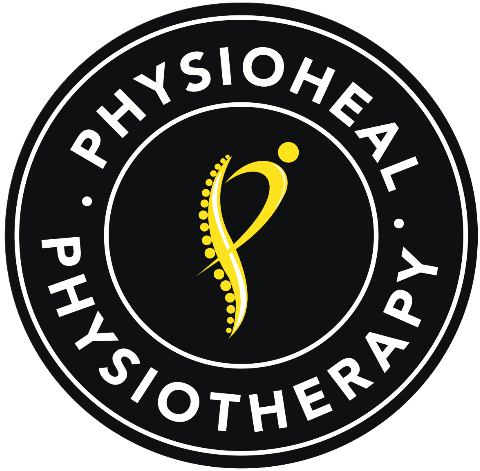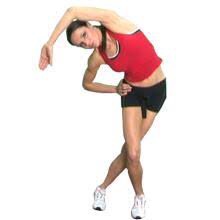Piriformis Syndrome is one medical condition where the piriformis muscle that is located in the buttock area starts to spasm and cause pain. This muscle can further irritate the nearby sciatic nerve and will cause pain, tingling, and numbness along the back side of the leg and into the foot. The pain feels similar to sciatic pain.
- This muscle starts at the lower spine and will connect to the upper portion of the femur or the thigh bone.
- The main function of this muscle is to rotate the hip and then turn the leg and foot outward.
- This muscle mostly runs diagonally with the sciatic nerve, which runs vertically right beneath it.
The common causes:
Now, before you proceed further to get medical treatment for Piriformis Syndrome, it is important to know the causes of the same. Well, the exact causes are pretty unknown to this date, but there are some suspected causes that doctors will recommend you to focus on. Some of those are listed below for your reference.
- You might feel muscle spasms in the piriformis syndrome, which can either be because of the irritation in the muscle itself or because of some irritation of the nearby structure like the hip or the sacroiliac joint.
- Another cause will be the tightening of the muscle, which is in response to the spasm or the injury. Getting doctor’s help immediately is highly advisable.
- Another cause behind piriformis syndrome will be swelling of the piriformis muscle. It can be a result of either spasm or injury.
- Sometimes, bleeding in the areas surrounding the piriformis muscle can result in unwanted piriformis syndrome.
Any one of the above-mentioned problems or a combination of many will affect the current piriformis muscle. It will result in buttock pain. The same issue can also affect the adjacent sciatic nerve, resulting in tingling, numbness or pain bear the calf, foot, or thigh areas.
So, if you feel any of these issues lately, it is highly recommended to check in with doctors and get the diagnosis done on time. The faster you can understand the problem, the easier it will be to get a result.
How to heal piriformis syndrome quickly
If you are feeling pain by sitting or covering some activities, make sure to avoid those positions that can otherwise trigger pain. Ice, heat, and rest are some of the ways to relieve symptoms. A physical therapist will suggest you a bunch of exercises and stretches, which will reduce the current sciatic nerve compression. Then you have osteopathic manipulative treatment, which is used for relieving pain and also increasing the motion range.
- Some healthcare providers are out there ready to offer anti-inflammatory medicines, injections with corticosteroids or anesthetic and muscle relaxants to get services.
- Then you have some other therapies like iontophoresis, which will use mild electric current to get started the treatment process.
- Some doctors try using injection with Botox to get some required results. Using the paralytic properties of Botox, doctors get to relieve muscle tightness for minimizing pain.
- In some instances, surgery seems to be the last resort, but only if the medications, injections, and therapeutic sessions seem to be of no use.
Discomfort from too much sitting? Inactive glutes? Buttock and leg pain? Though small in size, the piriformis could have a big impact on keeping the human movement system moving smoothly.
So if a patient comes to you and complains of pain in the buttock /or back which may or may not radiate to the leg. And gets aggravated with prolonged sitting, it can be a PIRIFORMIS syndrome.
The piriformis is a tiny muscle that originates on the anterior surface of the sacrum, travels through the greater sciatic foramen, and attaches to the greater trochanter of the femur (1,2). It accelerates hip external rotation, abduction, and extension.
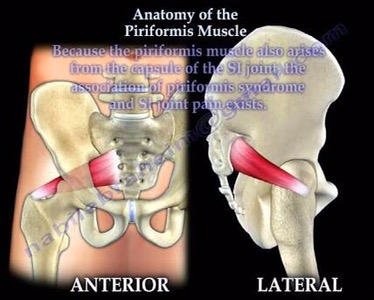
Piriformis syndrome has traditionally been described as a referred neural pain in the posterior hip and leg caused by hypertrophy or spasm of the piriformis.
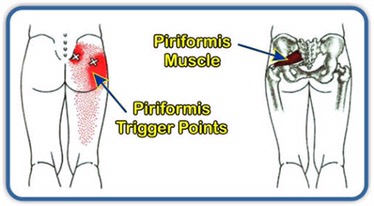
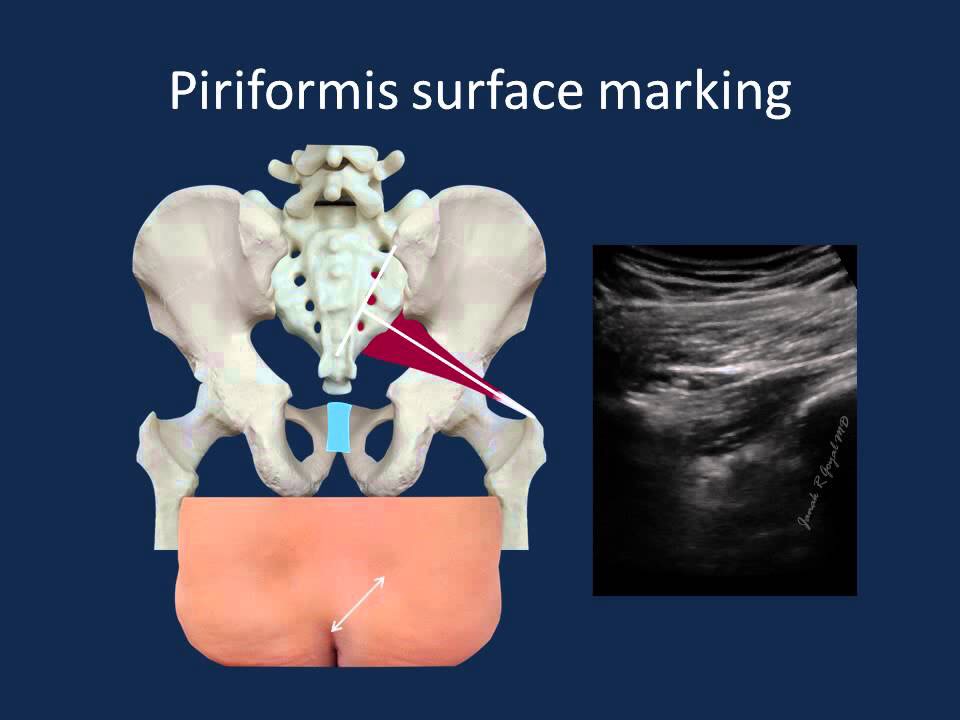
Pain when sitting is common, as is pain with hip flexion, adduction, and internal rotation.
While the signs and symptoms of the syndrome may be similar to other lumbo-pelvic pathology, the cause of piriformis syndrome remains relatively undefined as to reasons for development of spasm or hypertrophy of the muscle.
However, the reason why the piriformis is hypertrophied or in spasm is often described as “undefined and confusing.”
If the practitioner considers the principles of the kinetic chain and dysfunction of its linked components, it is not difficult to hypothesize why the piriformis may become involved in an impingement of the sciatic nerve. If the patient has chronic tightness of the hip flexor, the gluteus maximus will become reciprocally inhibited . This is significant because of the functional responsibility of the glute to decelerate medial femoral rotation during heel strike or functional movements. Since the piriformis is a primary external rotator of the femur, it becomes synergistically dominant in controlling the femur. This type of dominant function has the potential for causing the spasm, hypertrophy, or tightness described in most texts. The external hip rotators have also been noted as being the least stretched muscles of the lower body .
If a patient complains of pain associated with that described above, an effective strategy for correcting this type of dysfunction would be to first release the hip flexor through appropriate integrated flexibility techniques, then implement reeducation of the gluteus maximus through isolated strength training, and, finally, recondition the lumbo-pelvic hip complex through integrated functional movements in the appropriate range of motion, plane of motion, and speed, specific to the needs of the patient.
Here are the ways to improve and work on:
1. Foam Roll the Piriformis, Quadriceps and IT-Band
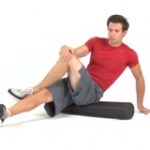 Sit on top of a foam roll with the foam roll placed directly on the back of the hip. Cross one leg over the other, placing your foot onto the opposite knee. Slowly roll the back of the hip, applying prolonged pressure on tender spots for roughly 30 seconds.
Sit on top of a foam roll with the foam roll placed directly on the back of the hip. Cross one leg over the other, placing your foot onto the opposite knee. Slowly roll the back of the hip, applying prolonged pressure on tender spots for roughly 30 seconds.
 Lie on your stomach with a foam roll placed under the front of your thigh. Support your upper body on your forearms. Slowly roll the front of your thigh, applying prolonged pressure on tender spots for roughly 30 seconds.
Lie on your stomach with a foam roll placed under the front of your thigh. Support your upper body on your forearms. Slowly roll the front of your thigh, applying prolonged pressure on tender spots for roughly 30 seconds.
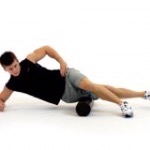 Lie on your side with the foam roll placed under your hip. Cross your top leg over the leg on the foam roll and place your foot on the floor. The leg on the foam roll should be raised off the floor and remain that way during the exercise. Slowly roll from the hip to the knee, rolling along the outer thigh, slightly in front of the hip and knee, applying prolonged pressure on tender spots for roughly 30 seconds.
Lie on your side with the foam roll placed under your hip. Cross your top leg over the leg on the foam roll and place your foot on the floor. The leg on the foam roll should be raised off the floor and remain that way during the exercise. Slowly roll from the hip to the knee, rolling along the outer thigh, slightly in front of the hip and knee, applying prolonged pressure on tender spots for roughly 30 seconds.
2. Statically Stretch the Piriformis, Biceps Femoris and Hip Flexors
Static Stretch: Piriformis:
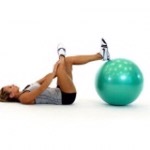 Lie on your back with one foot placed on top of a stability ball and the other foot crossed over your knee. Pull the ball toward your body with your heel. Press the crossed knee away from your until a stretch is felt in the back of your hip. Hold for 30 seconds.
Lie on your back with one foot placed on top of a stability ball and the other foot crossed over your knee. Pull the ball toward your body with your heel. Press the crossed knee away from your until a stretch is felt in the back of your hip. Hold for 30 seconds.
Static Stretch: Biceps Femoris
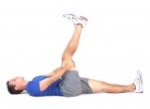 Lie on your back and bend one hip and knee 90-degrees. Leave the other leg extended on the floor. Hold your bent leg and extend at your knee, moving your lower leg straight into the air until a stretch is felt in the back of the upper leg. Hold for 30 seconds.
Lie on your back and bend one hip and knee 90-degrees. Leave the other leg extended on the floor. Hold your bent leg and extend at your knee, moving your lower leg straight into the air until a stretch is felt in the back of the upper leg. Hold for 30 seconds.
Static Stretch: Hip Flexors:
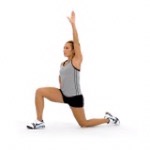 Kneel on your back leg, bending your front leg 90-degrees. Contract your glutes and shift your body forward. Raise the arm that is on the same side as the knee that is on the ground, stretching to the opposite side until a stretch is felt in the front of your pelvis. Rotate backwards and hold for 30-seconds.
Kneel on your back leg, bending your front leg 90-degrees. Contract your glutes and shift your body forward. Raise the arm that is on the same side as the knee that is on the ground, stretching to the opposite side until a stretch is felt in the front of your pelvis. Rotate backwards and hold for 30-seconds.
3. Leg Slides
 Begin by lying on your back with your knees bent and your feet flat on the floor. Breathe normally as you gently draw-in your navel towards your spine. Hold the contraction and relax as you slowly extend one leg until it is completely flat against the ground. Remember to keep your navel pulled in and be careful not to move your spine. Slowly return your leg to the starting position and repeat with opposite leg.
Begin by lying on your back with your knees bent and your feet flat on the floor. Breathe normally as you gently draw-in your navel towards your spine. Hold the contraction and relax as you slowly extend one leg until it is completely flat against the ground. Remember to keep your navel pulled in and be careful not to move your spine. Slowly return your leg to the starting position and repeat with opposite leg.
4. Floor Bridge
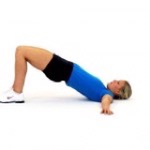 Lie on your back with your knees bent and place your feet flat on the ground, shoulder-width apart. Draw-in your navel and contract your glutes. Slowly push through your heels and lift your pelvis off the floor until your knees, hips and shoulders are in-line. Hold the top position for a few seconds and then slowly lower your pelvis back down to the floor.
Lie on your back with your knees bent and place your feet flat on the ground, shoulder-width apart. Draw-in your navel and contract your glutes. Slowly push through your heels and lift your pelvis off the floor until your knees, hips and shoulders are in-line. Hold the top position for a few seconds and then slowly lower your pelvis back down to the floor.
5. Lateral Tube Walking and Ball Squats
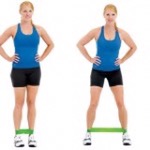 Stand with feet placed hip-width apart, knees slightly bent. Place a piece f tubing around your ankles. Keeping your feet straight, take small steps to one side. After recommended number of steps, repeat the exercise to the opposite side.
Stand with feet placed hip-width apart, knees slightly bent. Place a piece f tubing around your ankles. Keeping your feet straight, take small steps to one side. After recommended number of steps, repeat the exercise to the opposite side.
Ball Squats:
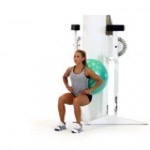 Stand with your feet pointed straight ahead and placed shoulder-width apart. Rest your low back against a stability ball that is placed on a wall. Keep your feet under or slightly in front of your knees. Slowly squat, bending your knees and keeping your feet straight. Keep your chest up, contract your glutes and press through your heels as you return to the starting position.
Stand with your feet pointed straight ahead and placed shoulder-width apart. Rest your low back against a stability ball that is placed on a wall. Keep your feet under or slightly in front of your knees. Slowly squat, bending your knees and keeping your feet straight. Keep your chest up, contract your glutes and press through your heels as you return to the starting position.
6. Tensor Fascia Latae Stretch
The tensor fascia latae is a small muscle on the outer hip, at the top of the IT band. It can be difficult to stretch so you may need to experiment with this position slightly until you can feel a stretch.
7. Calf muscle stretch/ Tendo Achilles muscle stretch
Stand facing the wall with both the palms on the wall. Stand little away from the wall. Put one leg forward and the other leg in straight line at the back. Bend the front leg from knee. Both the foot should be kept flat on the floor while doing the knee bending. Feel the stretch on the back leg around the calf muscle. Repeat this for the other leg now .
The value of an ice pack or ice massage:
Among all the recommended options, using an ice pack seems to be the most affordable, easy, and clever option to get rid of Piriformis Syndrome. Once you start feeling the pain near your buttock areas, it is time to ice that portion. In case certain activities are causing the pain to exaggerate, start applying an ice pack right after that activity.
- For this method to work, you need to lie down on your stomach in the most comfortable position. Place the ice pack in the painful area for around 20 minutes. Repeat this process once every 2 to 4 hours, as needed.
- If it is possible, an ice massage will be a delightful resort to get rid of buttock pain. For that, lie on your stomach and request someone to gently massage the area with a large ice cube. Make sure to limit the massage to around 10 minutes to avoid getting ice-burn.
These simple tricks and tips will actually help you to keep a check on Piriformis Syndrome and get the desired pain-relief as asked for. Yes, it might take some time at first, but worth the wait.
Written and compiled by
Dr Divya Gaur
Senior Physio and Manager
